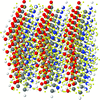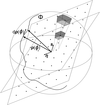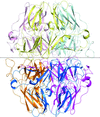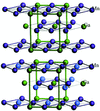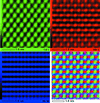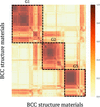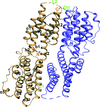issue contents
November 2018 issue

editorial
CHEMISTRY | CRYSTENG
Crystal engineering is moving into new domains with reducing distance and time scales and new ways of thinking about crystals and crystallography. Its intersections with other subjects are varied and numerous.
scientific commentaries
NEUTRON | SYNCHROTRON
A new `unwarping' algorithm presented by Liu and Yager in this issue constructs SAXS data consistent with experimental GISAXS data, eliminating many of the complications arising in GISAXS that are commonly modeled within the framework of the distorted-wave Born approximation. The method promises to open new pathways for processing, modeling and analyzing GISAXS data using techniques developed for SAXS.
PHYSICS | FELS
Better injectors resulting from careful iterative optimization used at high repetition XFELs in combination with better detectors and further developed algorithms might, in the not so distant future, result in a `resolution revolution' in SPI, enabling the molecular and atomic imaging of the dynamics of biological macromolecules without the need to freeze or crystallize the sample.
research letters
BIOLOGY | MEDICINE
Photocaging in combination with X-ray solution scattering allows for the time-resolved study of protein dynamics in solution. This method is versatile and allows for accurate triggering of protein function.
research papers
PHYSICS | FELS
Rayleigh-scattering microscopy permits tracking and sizing of aerosolized particles down to 40 nm in diameter. It lays the foundation for lab-based injector development and online injection diagnostics for X-ray free-electron laser (XFEL) research.
MATERIALS | COMPUTATION
Download citation


Download citation


The structures of a family of long repeat mixed-layer hexaferrites are solved with atomic resolution for the first time using synchrotron X-ray diffraction.
PHYSICS | FELS
This article presents a discussion of the generalization of the effective-form-factor approximation applied to describe scattering patterns with a severe degree of ionization and a demonstration of its applicability to X-ray free-electron laser (XFEL)-based nanocrystallography via realistic radiation-damage simulation of nanocrystals.
CHEMISTRY | CRYSTENG
Download citation


Download citation


Temperature changes induced several solid-form conversions in 2-propyl-1H-benzimidazole. Three new crystal forms have been identified and characterized by various methods. A key structural aspect of these form conversions lies in the conformational changes around the propyl chains. Those changes drive polymorphic form changes, as well as low/high-temperature phase conversions. One phase conversion involves conformational change.
PHYSICS | FELS
Signal-to-noise ratio, spatial resolution and information capacity of tomographic coherent diffractive imaging are investigated; the results are expected to be useful for the design and analysis of synchrotron and XFEL-based diffractive imaging experiments.
PHYSICS | FELS
Data-processing workflow for single-particle imaging experiments at X-ray free-electron lasers is presented. The analysis developed here revealed nanoscale features of the PR772 virus with a resolution better than 10 nm and without any symmetry constraints.
NEUTRON | SYNCHROTRON
Grazing-incidence X-ray-scattering (GISAXS) images contain distortions caused by refraction and multiple scattering. A new method is presented for computationally unwarping GISAXS data. The experimental data are iteratively fitted to reconstruct an estimate of the true underlying reciprocal-space scattering.
PHYSICS | FELS
A method for measuring the three-phase invariants of crystals in any space group by inspection of convergent-beam electron diffraction patterns recorded under three-beam conditions is presented.
BIOLOGY | MEDICINE
Crystal structures of the noncollagenous domains of the collagen type IV α1–α5 chains provide structural insight into Alport's syndrome (a genetic kidney disorder) and the first views of the components of Goodpasture's autoimmune disease epitopes. These structures define key folding motifs for collagen IV scaffolding of basement membranes, support the operation of mechanisms for restricting the self-assembly of noncollagenous domains, and raise the possibility that homohexamers of α1 or α3 chains could occur in nature.
PDB references: collagen type IV α1α2α1NC1, 5nax; α1NC1, 5nay; α2NC1, 5nb2; α3NC1, 5nb0; α4NC1, 5nb1; α5NC1, 5naz
NEUTRON | SYNCHROTRON
In this study, the behaviour of the detergent-solubilized tetrameric, full-length ionotropic glutamate receptor GluA2 in solution was investigated using small-angle neutron scattering. It was found that the GluA2 solution structure is preferentially in a compact form in the resting state as well as in the presence of AMPA and of the negative allosteric modulator GYKI-53655.
MATERIALS | COMPUTATION
The crystal structures and magnetic properties of Mn3−xFexGa alloys (x = 0, 0.2, 0.4, 0.6, 0.8, 1) can be extensively tailored by different heat-treatment conditions. This investigation sheds light on tuning the crystal structures of these materials via heat treatment towards wide functionalities for technological applications.
PHYSICS | FELS
The study of the dynamics of radiation-sensitive soft-matter suspensions is demonstrated by means of sequential-shot X-ray photon correlation spectroscopy below the radiation-damage threshold at the SACLA free-electron laser.
CHEMISTRY | CRYSTENG
Download citation


Download citation


Using various experimental methods including X-ray diffraction and electron microscopy, this work determines the range and nature of the chemical ordering in Pb(Cd1/3Nb2/3)O3 (PCN). The influence of the chemical ordering on the dielectric property is also discussed, based on the similarities and differences between PCN and other classical relaxors.
CHEMISTRY | CRYSTENG
Download citation


Download citation


A 6-component organic-salt alloy of naftopidil with hydroxy-substituted benzoic acids is designed based on a recurrent supramolecular synthon and the replacement of coformer acids in the crystal structure. Isostructurality of five binary salts leads to the crystallization of multicomponent salt alloys. One 6-component crystal, five 5-component, ten 4-component and ten 3-component organic-salt alloys of naftopidil with carboxylic acids are reported.
MATERIALS | COMPUTATION
The ordered stacking of solute atoms based on elliptically shaped self-adapted clustering leads to the generation of the quasi-unit cell. The bonding of these ellipse-like quasi-unit-cell rods by the Mg atomic columns forms a two-dimensional planar structure.
MATERIALS | COMPUTATION
A machine-learning method has been developed to measure the similarity between materials, focusing on specific physical properties. The information obtained can be utilized to discover the subgroup structure of materials, understand the underlying mechanisms, and support the prediction of the physical properties of materials.
CHEMISTRY | CRYSTENG
Download citation


Download citation


The crystal and molecular structures of the popular anti-inflammatory drug ketoprophen were examined. The centrosymmetric form of ketoprophen (β-ket) that has been reported so far, was structurally, geometrically and energetically compared with the non-centrosymmetric form (S-enantiomer) of ketoprophen (α-ket). The molecules in both crystal structures are in similar arrangements, with antiparallel-oriented benzophenone moieties.
CRYO | EM
Deep Consensus performs particle pruning in cryo-EM image-processing workflows using a smart consensus.
BIOLOGY | MEDICINE
The structure of a viral poly(ADP-ribose) polymerase 1 (PARP-1)-interacting protein from murine gammaherpesvirus 68 (MHV-68) is reported. Structure-based mutagenesis revealed residues that are critical for function and interaction with PARP-1, and a recombinant MHV-68 harboring mutations of these three residues showed severely attenuated viral replication in infected cells and mice. A homologous vPIP protein of Kaposi's sarcoma-associated herpesvirus also interacted with PAPR-1 and disrupted its inhibitory function, suggesting the conserved molecular mechanism of vPIPs to facilitate viral replication among gammaherpesviruses.
PDB reference: viral PARP-1-interacting protein, 6a4v



 journal menu
journal menu




 access
access












